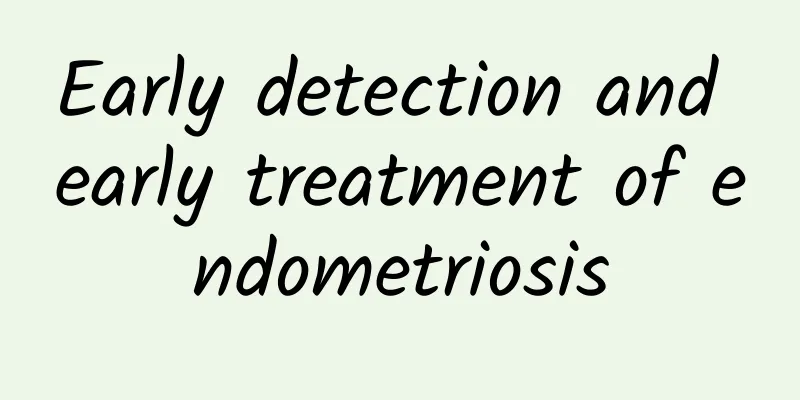Early detection and early treatment of endometriosis

|
Endometriosis is a common gynecological disease. The occurrence of endometriosis brings great side effects to women's body and mind. Many patients with endometriosis usually have symptoms such as dysmenorrhea and irregular menstruation. Of course, if endometriosis is not treated in time, it will also lead to female infertility. Therefore, women with endometriosis must actively treat it. Endometriosis is sometimes not easy to detect, and some women do not understand their own physical health, so it is easy to wait until endometriosis causes greater pain. symptom 1. Dysmenorrhea: It is a common and prominent symptom, mostly secondary, that is, from the onset of endometriosis, patients complain that they had no pain during menstruation in the past, but dysmenorrhea began to occur from a certain period. It can occur before, during and after menstruation. Some people suffer from severe dysmenorrhea and need to stay in bed or take medication to relieve pain. The pain often increases with the menstrual cycle. Due to the increase in estrogen levels, the ectopic endometrium proliferates and swells. If it is affected by progesterone, it will bleed and irritate local tissues, causing pain. If it is endometriosis, uterine muscle contracture and dysmenorrhea will be more prominent. Dysmenorrhea may be due to vascular congestion. After the patient's ectopic tissue has no bleeding and menstruation, the ectopic endometrium gradually atrophies and dysmenorrhea disappears. In addition, in pelvic endometriosis, many inflammatory processes can be detected, and it is likely that the local inflammatory process is accompanied by active peritoneal lesions, resulting in pain or tenderness caused by polypeptide substances such as prostaglandins and kallikrein. However, the degree of pain often does not reflect the extent of the disease found by laparoscopy. Endometriosis is clinically obvious, but painless menstruation accounts for about 25%. The psychological state of women can also affect pain. 2. Menstruation: Endometriosis often causes increased menstrual volume and prolonged menstruation. It may be caused by endometrial hyperplasia, but most cases are accompanied by ovarian insufficiency. 3. Pregnancy: Endometriosis patients are often accompanied by infertility. According to reports from Tianjin and Shanghai, primary infertility accounts for 41.5-43.3%, and secondary infertility accounts for 46.6-47.3%. The causal relationship between infertility and endometriosis is still controversial. Pelvic endometriosis often causes adhesions around the fallopian tubes, affecting the collection of oocytes or causing tubal obstruction. Or infertility may be caused by ovarian lesions affecting the normal ovulation process. However, some people believe that long-term infertility and menstrual interruption can cause the chance of endometriosis; once pregnant, the ectopic endometrium will be suppressed and atrophy. 4. Pain during sexual intercourse: Endometriosis occurs in the rectouterine fossa and vaginal rectal septum, causing swelling of the surrounding tissues, affecting sexual life and aggravating premenstrual discomfort. 5. Bowel distension: usually occurs before or after menstruation. The patient will feel pain when stool passes through the rectum, but not at other times. It is a typical symptom of endometriosis near the uterine rectal fossa and rectum. Occasionally, the ectopic endometrium is deep into the rectal mucosa, and there is rectal bleeding during menstruation. Endometriosis is similar to cancer because it is narrow around the rectum, with mild, severe and obstructive symptoms. 6. Bladder symptoms: Most of them are endometriosis to the bladder. They have cyclical urination frequency and urinary pain. Cyclic hematuria may occur when the bladder mucosa is involved. Endometriosis in the abdominal scar and umbilicus has cyclical localized lumps and pain. Normally, the endometrium covers the surface of the uterine body. If for some reason, the endometrium grows in other parts of the body, it may become endometriosis. Histologically, the ectopic endometrium is surrounded by endometrial glands and stroma. With the change of estrogen levels, that is, the change of menstrual cycle, its function has obvious changes, but only part of it is affected by progesterone, which can produce a small amount of "menstruation" and cause various clinical phenomena. |
<<: How to check for endometriosis
Recommend
Sweetie pinworm diet? Malnutrition and anemia
Celebrities try every possible means to lose weig...
I can’t lose weight after giving birth! Body sculpture outpatient consultation increased by 30%
The birth boom in the Year of the Dragon has brou...
What is the size range of the gestational sac for painless abortion?
If you want to have a painless abortion, you need...
Is ovarian cyst a serious disease?
Ovarian cysts are a common gynecological disease ...
What are the reasons that easily lead to cervical erosion? Ten dietary recommendations for treating cervical erosion
There are many reasons for cervical erosion, and ...
Is the menstrual flow normal in the first month after medical abortion?
Is the menstrual flow normal in the first month a...
Brief analysis of the precautions for chronic cervicitis
According to recent surveys and studies, the inci...
How much does it cost to treat cervical warts?
Cervical warts are not as terrible as many women ...
What are the details of dietary taboos after abortion?
Abortion is very harmful to female friends, and w...
What's wrong with menstruation after 40 days? What should I do?
What's wrong with menstruation after 40 days?...
What symptoms will appear after pregnancy with uterine fibroids? Will uterine fibroids cause postpartum bleeding?
A patient with uterine fibroids asks: What happen...
Chocolate cyst examination method
Regarding the methods of examining chocolate cyst...
Treatment of pelvic inflammatory disease of damp-heat and stasis type
Traditional Chinese medicine can classify pelvic ...
The best hospital for menopause treatment
A detailed introduction to which hospital is best...
Uterine fibroids may be caused by sexual dysfunction
Uterine fibroids may be caused by sexual disorder...









